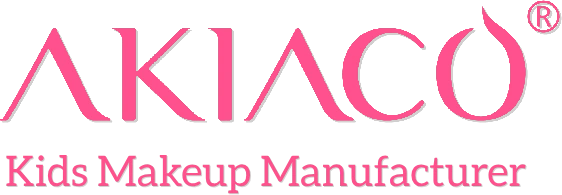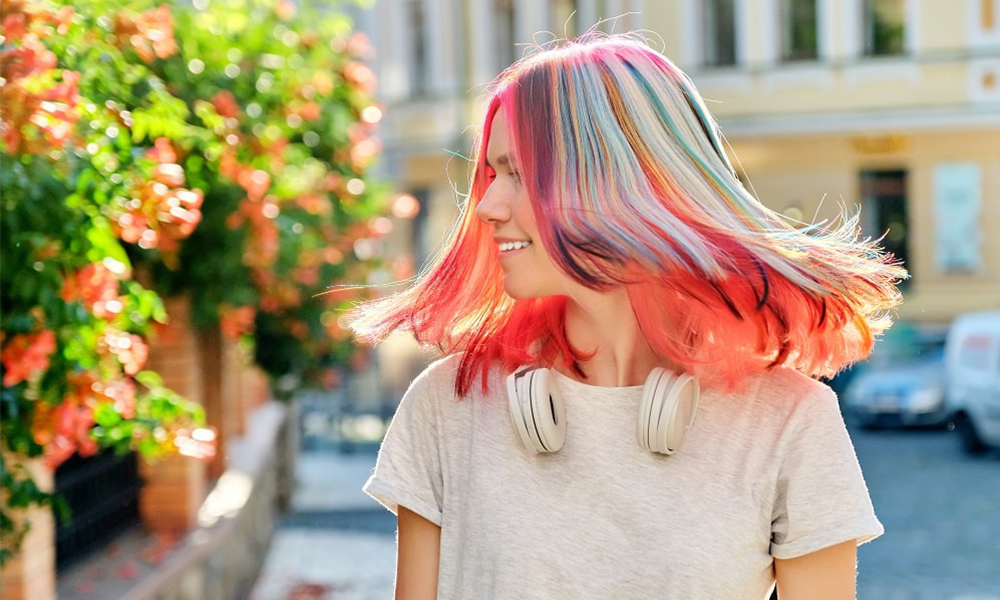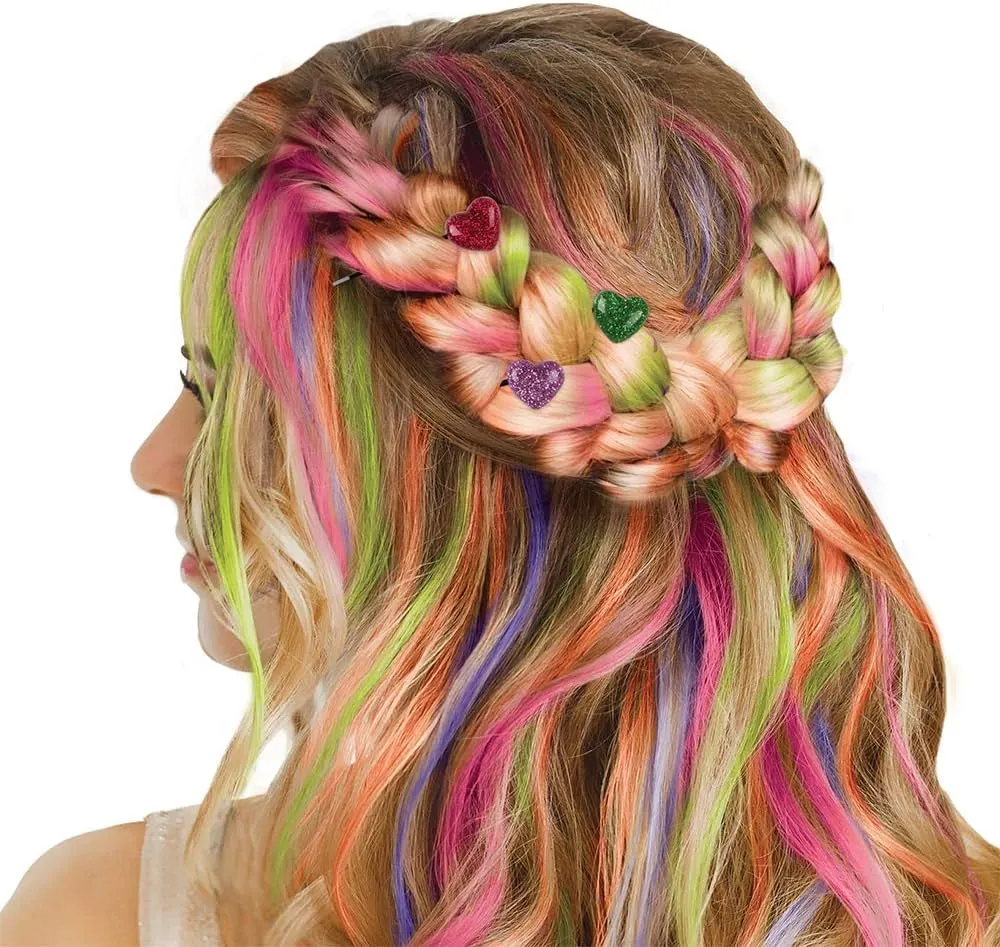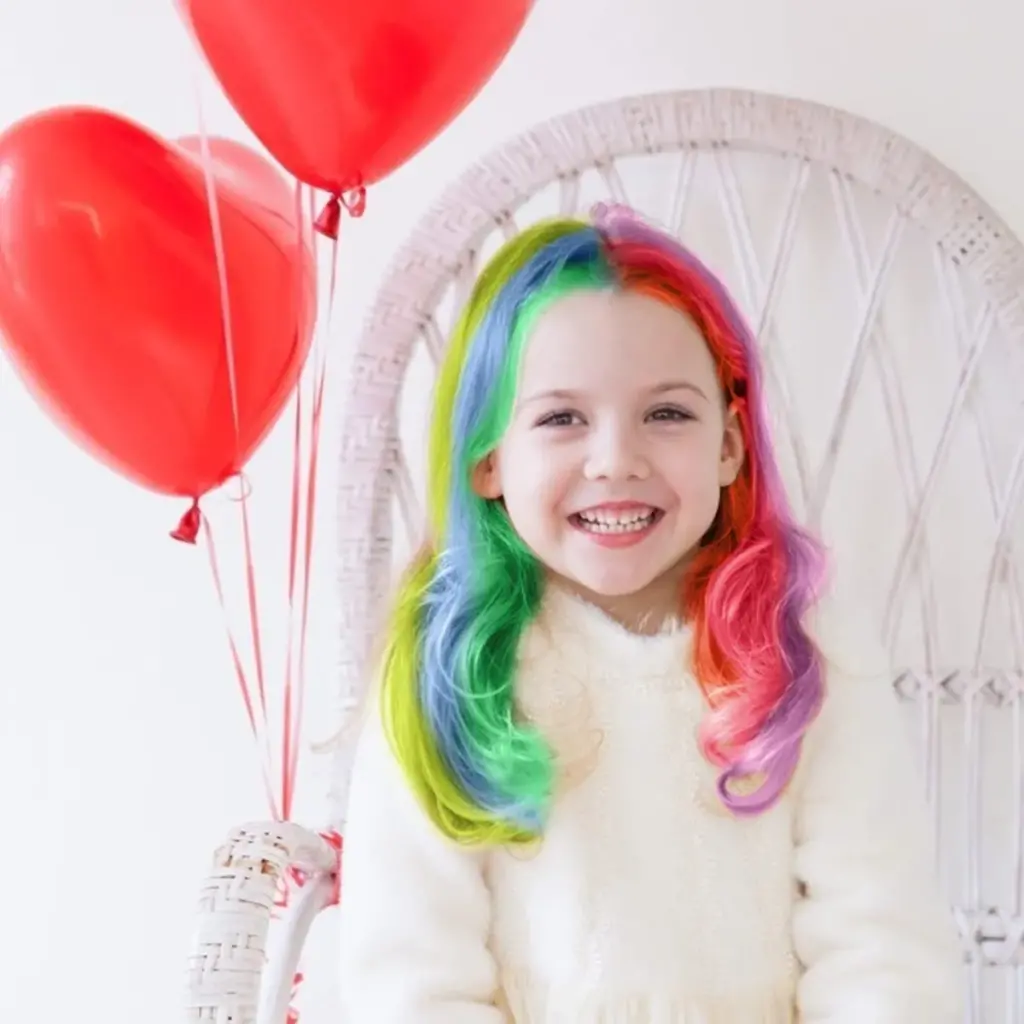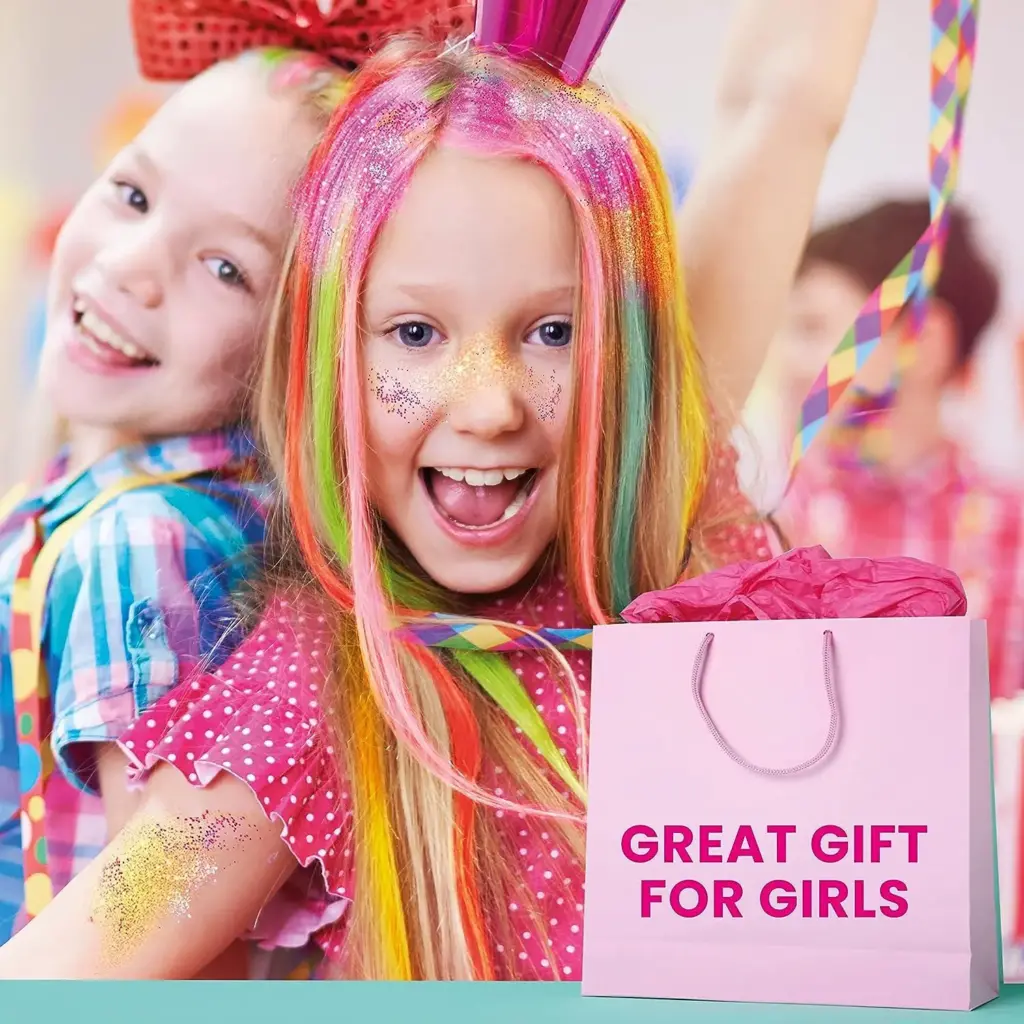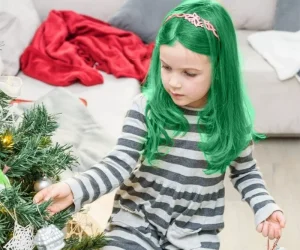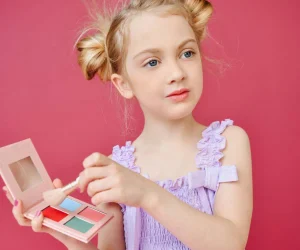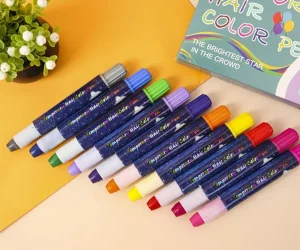What Does Hair Chalk Do to Your Hair? Exploring Fun Colors
Table of Contents
Hair chalk is a fun, temporary way to add vibrant colors to hair without long-term commitment. It allows kids and teens to experiment with bold looks safely. Knowing how it works, its ingredients, and how it differs from other color products helps parents and educators guide young users.
What hair chalk is and how it works
Hair chalk is essentially a colored powder or wax that deposits pigment onto the hair surface. It doesn’t penetrate the hair shaft deeply, which is why it’s considered temporary. The pigments cling to the cuticle, allowing bright, visible streaks that wash out over a few shampoos.
Application typically involves rubbing or pressing the chalk onto strands of hair. Slight moisture can enhance color transfer, while dry hair might produce lighter streaks. Hair chalk offers a non-permanent option for experimenting with colors without chemical processing.
Temporary vs. semi-permanent hair coloring
Hair chalk is strictly temporary, unlike semi-permanent dyes that penetrate the outer layers of the hair shaft. Semi-permanent colors usually last several weeks and gradually fade with washing, while hair chalk can be removed after one or two washes, depending on hair texture and color intensity.
This distinction matters for safety and hair care. Temporary hair chalk minimizes chemical exposure, making it suitable for young users, while semi-permanent dyes often contain ammonia, peroxide, or other agents that may irritate sensitive scalps or damage hair over time.
Key ingredients in hair chalk for children and teens
Hair chalk products designed for children generally contain color pigments, waxes, or water-soluble bases, along with mild conditioners. These ingredients allow for easy application and removal while limiting harsh chemicals.
Most formulations avoid ammonia, peroxide, or heavy metals to reduce irritation or allergic reactions. According to safety assessments by the Cosmetic Ingredient Review (CIR, 2022), these child-friendly products are generally safe when used as directed, but supervision is recommended to prevent accidental ingestion or eye contact.
How Hair Chalk Changes Hair Appearance
Hair chalk dramatically alters hair color without permanent commitment. The effect depends on hair type, application technique, and color choice.
Color intensity and coverage
The intensity of hair chalk depends on the pigment concentration and hair texture. Fine or light-colored hair tends to show brighter, more vivid colors, while thicker or darker hair may need multiple applications for noticeable coverage.
Even pressure during application and slight dampening can enhance color transfer. Layering chalk gradually allows for control over saturation, reducing streakiness. Proper technique ensures even coverage without damaging the hair cuticle.
Blending multiple colors for creative styles
Hair chalk can be combined to create gradients, highlights, or rainbow effects. Blending requires careful layering of colors while preventing smudging or muddy tones. Using separate sections or foil strips can help maintain distinct shades.
Creative techniques let children and teens experiment safely with fun hairstyles. For example, alternating pastel pink and blue streaks can create a subtle ombré effect that washes out easily, offering temporary versatility without chemical dyes.
Differences on light vs. dark hair
Hair color affects the final result of hair chalk. Light or blonde hair reflects pigments clearly, producing bright and vivid streaks. Dark hair often absorbs less pigment, resulting in muted or pastel tones unless applied over dampened strands or pre-lightened hair.
This variability is important for setting realistic expectations. While hair chalk can be fun on any hair type, users may need to adjust techniques or apply multiple layers to achieve the desired brightness on darker hair.
The Application Process and Tips
Applying hair chalk correctly ensures vibrant, even color while minimizing mess and potential damage. Proper preparation and technique make the process easier for kids and teens, producing playful yet controlled results that can be washed out safely.
Preparing hair for chalk application
Before applying hair chalk, hair should be clean and slightly damp. Lightly misting with water improves pigment adherence and reduces powder fallout. Detangling hair is also important to prevent uneven color distribution.
Using a towel or cape can protect clothing and surfaces from stains. Sectioning hair into small strands allows precise application, making it easier to target specific areas for streaks, highlights, or patterns. Proper prep sets the stage for vibrant, controlled color.
Techniques for even coverage
For uniform color, press or rub the chalk along the length of each strand using consistent pressure. Finger application, brushes, or sponges can be used depending on hair thickness and desired effect.
Layering colors gradually ensures intensity without streaks or uneven patches. Rotating between strands and working methodically helps avoid clumping or patchiness. Lightly brushing or combing afterward blends pigments for a polished look.
Fixing and enhancing color with hair products
After applying chalk, a light spritz of water or styling spray can help set the color temporarily. Some users also apply leave-in conditioner or hairspray to prevent fallout and extend wear during the day.
It’s important to avoid heavy oils or silicones before application, as these can reduce pigment adhesion. Properly setting the chalk maintains vibrancy and allows for safe, fun, and mess-free styling for kids and teens.
Hair Chalk and Hair Health
While hair chalk is designed to be temporary and safe, it can still affect hair texture and overall appearance.
Effects on hair texture
Hair chalk coats the hair cuticle with pigments, which can make strands feel slightly coarse or chalky. This texture change is usually temporary and disappears after washing.
Repeated applications without proper cleansing may cause minor roughness or tangling, especially on fine or dry hair. Combing through colored sections gently helps maintain smoothness and prevents breakage.
Potential dryness or residue concerns
Some hair chalk formulas contain wax or powdery pigments that can leave residue on the scalp or hair. This residue can cause dryness or make hair feel stiff if not washed out properly.
To reduce dryness, conditioning after removal is recommended. Light conditioners or leave-in treatments restore moisture and maintain softness, ensuring hair remains healthy even with frequent temporary coloring.
Frequency of use and safety for children
Hair chalk is generally safe for children and teens when used occasionally. Daily use can increase residue buildup and dryness, so moderation is advised.
Supervision is important to prevent accidental ingestion, eye contact, or over-application. Following manufacturer guidelines and washing hair thoroughly after each use helps maintain hair health while enjoying creative, temporary colors safely.
Washing and Removing Hair Chalk
Hair chalk is designed to be temporary, but proper removal is important for maintaining hair health and preventing residue buildup.
How long hair chalk lasts on hair
Hair chalk typically lasts until the next shampoo or two, depending on hair type, color intensity, and exposure to water or friction. Light-colored hair may retain vibrant streaks longer, while dark hair often shows pastel or muted tones that fade more quickly.
External factors such as brushing, sweating, or rain can also accelerate fading. Generally, one or two washes remove most pigments, but some stubborn shades may require gentle extra washing.
Best methods for removing chalk safely
To remove hair chalk safely, use lukewarm water and a mild shampoo. Lather thoroughly, focusing on colored sections, and rinse completely. Conditioner can follow to restore softness and smoothness.
For stubborn streaks, repeat washing rather than using harsh scrubbing, which can damage the hair cuticle. Using a wide-tooth comb while shampooing helps loosen pigments without pulling or breaking hair.
Common issues during removal
Some hair chalk colors, especially bright or dark pigments, may leave light residue or staining on towels, clothing, or bathroom surfaces. Washing over-dried or heavily layered chalk can also cause tangling or minor breakage.
To minimize issues, section hair during washing and rinse thoroughly. Avoid vigorous rubbing, and follow up with a gentle conditioner to keep hair smooth. These steps help ensure complete removal without compromising hair health.
Myths and Misconceptions About Hair Chalk
Hair chalk is often misunderstood, leading to myths that may discourage safe, creative use. Separating fact from fiction helps parents and teens enjoy temporary color while maintaining healthy hair.
“Hair chalk damages hair permanently” myth
A common myth is that hair chalk permanently damages hair. In reality, hair chalk only coats the hair surface and washes out easily. Unlike chemical dyes, it doesn’t penetrate the hair shaft or alter its structure.
Temporary texture changes like slight roughness or stiffness usually disappear after washing. Occasional use with proper cleansing and conditioning is generally safe for children and teens.
Confusion with permanent dyes or sprays
Some users confuse hair chalk with permanent dyes or aerosol sprays. Unlike permanent products, hair chalk is water-soluble or wax-based, leaving hair color temporary and fully removable with shampoo.
This confusion can cause unnecessary worry about hair health. Educating users about the non-chemical nature of hair chalk clarifies that it’s a safe option for creative, short-term styling.
Misunderstanding color fading and streaking
Another misconception is that fading or uneven streaks indicate damage. Hair chalk naturally fades with washing, friction, or exposure to moisture. Darker hair may show pastel tones rather than bright colors, which can be mistaken for uneven application.
Understanding how hair type and pigment interact helps set realistic expectations. Fading and streaking are normal and don’t reflect harm to the hair itself.
Creative Uses and Styling Ideas
Hair chalk opens up countless possibilities for playful, temporary hair designs. Knowing how to style and combine colors safely helps kids and teens experiment creatively while keeping hair healthy.
Fun hairstyles for parties and school events
Hair chalk is perfect for adding streaks, highlights, or patterns for special occasions. Braids, ponytails, or buns can showcase colorful strands, creating vibrant looks for birthday parties or school events.
Sectioning hair before applying chalk allows for precise designs and prevents color mixing. Simple techniques like twisting or crimping strands can enhance the visual impact without adding chemicals or permanent dyes.
Combining hair chalk with other temporary hair products
Hair chalk can be paired with other temporary products like colored hairsprays, glitter gels, or styling mousses. This combination allows more complex styles, such as ombré effects or glittery streaks, while still remaining washable.
Applying hair chalk first and letting it set before adding sprays or gels helps maintain color intensity and prevent smudging. These safe layering methods give kids and teens more freedom to express creativity.
Seasonal or holiday-inspired color trends
Temporary hair chalk is ideal for seasonal or holiday-themed looks. Pastels in spring, bright summer streaks, or festive red and green for holidays allow for playful experimentation without commitment.
By adjusting color combinations to match events, users can enjoy trends and celebrations safely. Because the chalk washes out easily, styles can change with each season, making it a flexible option for fun, temporary hair color.
Safety Tips for Kids and Teens Using Hair Chalk
Hair chalk is generally safe, but precautions help prevent irritation, maintain hair health, and ensure a positive experience. Following basic safety guidelines is important for young users.
Avoiding scalp irritation or allergic reactions
Some hair chalk formulas contain pigments or waxes that may irritate sensitive scalps. Always perform a patch test on a small area of skin or hair before full application.
Choosing products labeled hypoallergenic and avoiding areas close to the scalp can reduce risk. If redness, itching, or discomfort occurs, remove the chalk immediately and wash hair thoroughly.
Keeping hair healthy during frequent use
Frequent use of hair chalk can leave residue, dryness, or slight roughness. To maintain hair health, alternate chalk use with normal hair care routines, including gentle shampooing and conditioning.
Limiting daily application prevents buildup and preserves natural hair softness. Using detangling combs and avoiding excessive rubbing during removal also protects the hair cuticle from damage.
Supervision and hygiene tips for young users
Children should be supervised during application to prevent accidental ingestion, eye contact, or staining of skin and clothing. Wearing old clothes and using towels or capes protects fabrics.
Encourage washing hands after use and cleaning brushes or applicators regularly. Supervised routines ensure safe, hygienic, and enjoyable hair chalk experiences for kids and teens.
Conclusion
Hair chalk offers a fun, temporary way for kids and teens to experiment with color without long-term damage. Understanding application, removal, and safety ensures vibrant results while protecting hair health. With proper care, hair chalk can be a safe, creative outlet for playful styles.
FAQ
Yes, hair chalk can transfer to fabrics, especially when wet. To avoid stains, use old clothing, towels, or capes during application. Washing hair and covering surfaces helps prevent accidental color transfer.
Hair chalk can be applied over dyed or chemically treated hair, but results vary. Pre-lightened hair may show more vivid colors, while dark or saturated dyes may produce muted or pastel streaks. Proper sectioning improves coverage.
Brushing immediately after applying hair chalk can smear or remove pigment. Waiting a few minutes allows the color to set. Gentle combing afterward ensures even distribution and avoids breakage or streaks.
Slightly damp hair can improve color transfer, but fully wet hair may dilute pigments and create uneven streaks. Light misting is recommended for optimal adhesion while maintaining hair texture and vibrancy.
Hair chalk is generally safe for children, but very young kids may be more prone to accidental ingestion or eye contact. Supervision is essential, and products should be labeled non-toxic and appropriate for their age group.
